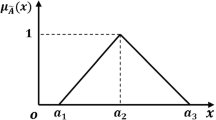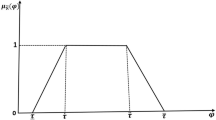Abstract
A decision-maker often encounters a state of uncertainty as well as hesitancy due to various unpredictable factors while solving real-world optimization problems. Due to ambiguity in the decision-making process, the parameters and decision variables of an optimization model generally fail to have the exact values. To deal with such realistic uncertain conditions, the concept of intuitionistic fuzzy numbers has been employed widely. In this article, a model of the linear fractional programming problem having multiple objectives with all the parameters and decision variables expressed as intuitionistic fuzzy numbers has been presented. To solve the problem, we first linearize the fractional model using appropriate transformations, and thereafter utilizing the accuracy function and intuitionistic fuzzy programming, the equivalent optimization model is obtained. The conflicting nature of the multiple objectives in the linearized model has been handled using the linear and exponential membership/non-membership functions applying normal, optimistic, pessimistic, and mixed approaches. Moreover, to validate the various equivalent constructions of the original problem, the underlying theorems are also proved at the relevant places. In last, a practical application related to production process in the textile industry has been constructed and solved using the proposed algorithm, and further, a comparison is drawn among various approaches to establish the efficacy of the proposed modelling and developed algorithm.











Similar content being viewed by others
References
Ali, I., Gupta, S., & Ahmed, A. (2019). Multi-objective linear fractional inventory problem under intuitionistic fuzzy environment. International Journal of System Assurance Engineering and Management, 10, 173–189.
Angelov, P. P. (1997). Optimization in an intuitionistic fuzzy environment. Fuzzy Sets and Systems, 86, 299–306.
Arya, R., Singh, P., & Bhati, D. (2018). A fuzzy based branch and bound approach for multi-objective linear fractional (MOLF) optimization problems. Journal of Computational Science, 24, 54–64.
Arya, R., Singh, P., Kumari, S., & Obaidat, M. S. (2020). An approach for solving fully fuzzy multi-objective linear fractional optimization problems. Soft Computing, 24, 9105–9119.
Atanassov, K. T. (1986). Intuitionistic fuzzy sets. Fuzzy Sets and Systems, 20, 87–96.
Bahri, O., & Talbi, E. G. (2021). Robustness-based approach for fuzzy multi-objective problems. Annals of Operations Research, 296, 707–733.
Bajalinov, E. B. (2003). Linear-fractional programming: Theory, methods, applications and software. Dordrecht: Kluwer Academic Publishers.
Bharati, S. K. (2019). Trapezoidal intuitionistic fuzzy fractional transportation problem. In J. Bansal, K. Das, A. Nagar, K. Deep, & A. Ojha (Eds.), Soft computing for problem solving: Advances in intelligent systems and computing (pp. 833–842). Berlin: Springer.
Bhati, D., & Singh, P. (2017). Branch and bound computational method for multi-objective linear fractional optimization problem. Neural Computing and Applications, 28, 3341–3351.
Chakraborty, M., & Gupta, S. (2002). Fuzzy mathematical programming for multi objective linear fractional programming problem. Fuzzy Sets and Systems, 125, 335–342.
Chang, C.-T. (2017). Fuzzy linearization strategy for multiple objective linear fractional programming with binary utility functions. Computers & Industrial Engineering, 112, 437–446.
Charnes, A., & Cooper, W. W. (1962). Programming with linear fractional functionals. Naval Research Logistics Quarterly, 9, 181–186.
Craven, B. D. (1988). Fractional programming. Berlin: Heldermann Verlag.
Das, S. K., Mandal, T., & Edalatpanah, S. A. (2017). A new approach for solving fully fuzzy linear fractional programming problems using the multi-objective linear programming. RAIRO-Operations Research, 51, 285–297.
Debnath, I. P., & Gupta, S. K. (2019). Exponential membership function and duality gaps for I-fuzzy linear programming problems. Iranian Journal of Fuzzy Systems, 16(2), 147–163.
De, S. K., & Sana, S. S. (2015). Backlogging EOQ model for promotional effort and selling price sensitive demand-an intuitionistic fuzzy approach. Annals of Operations Research, 233(1), 57–76.
Dubey, D., Chandra, S., & Mehra, A. (2012). Fuzzy linear programming under interval uncertainty based on ifs representation. Fuzzy Sets and Systems, 188, 68–87.
Ebrahimnejad, A., Ghomi, S. J., & Mirhosseini-Alizamini, S. M. (2018). A revisit of numerical approach for solving linear fractional programming problem in a fuzzy environment. Applied Mathematical Modelling, 57, 459–473.
El Sayed, M. A., & Abo-Sinna, M. A. (2021). A novel approach for fully intuitionistic fuzzy multi-objective fractional transportation problem. Alexandria Engineering Journal, 60, 1447–1463.
Guzel, N., & Sivri, M. (2005). Taylor series solution of multi objective linear fractional programming problem. Trakya University Journal of Science, 6, 91–98.
Isbell, J. R., & Marlow, W. H. (1956). Attrition games. Naval Research Logistics Quarterly, 3, 71–93.
Jayalakshmi, M. (2015). Solving intuitionistic fuzzy linear fractional programming problem. International Journal of Scientific Research and Engineering Studies, 2, 29–32.
Mahajan, S., & Gupta, S. K. (2021a). On fully intuitionistic fuzzy multiobjective transportation problems using different membership functions. Annals of Operations Research, 296, 211–241.
Mahajan, S., & Gupta, S. K. (2021b). On optimistic, pessimistic and mixed approaches under different membership functions for fully intuitionistic fuzzy multiobjective nonlinear programming problems. Expert Systems with Applications, 168, 114309.
Mesiar, R., Kouchakinejad, F., & Šipošová, A. (2018). On fuzzy solution of a linear optimization problem with max-aggregation function relation inequality constraints. Annals of Operations Research, 269, 521–533.
Mishra, S., & Ghosh, A. (2006). Interactive fuzzy programming approach to bi-level quadratic fractional programming problems. Annals of Operations Research, 143, 251–263.
Ozkok, B. A. (2020). An iterative algorithm to solve a linear fractional programming problem. Computers & Industrial Engineering, 140, 106234.
Pal, B. B., Moitra, B. N., & Maulik, U. (2003). A goal programming procedure for fuzzy multiobjective linear fractional programming problem. Fuzzy Sets and Systems, 139, 395–405.
Pop, B., & Stancu-Minasian, I. M. (2008). A method of solving fully fuzzified linear fractional programming problems. Journal of Applied Mathematics and Computing, 27, 227–242.
Ramík, J., & Vlach, M. (2012). Aggregation functions and generalized convexity in fuzzy optimization and decision making. Annals of Operations Research, 195, 261–276.
Rani, D., Gulati, T. R., & Garg, H. (2016). Multi-objective non-linear programming problem in intuitionistic fuzzy environment: Optimistic and pessimistic view point. Expert Systems with Applications, 64, 228–238.
Sahoo, D., Tripathy, A. K., & Pati, J. K. (2022). Study on multi-objective linear fractional programming problem involving pentagonal intuitionistic fuzzy number. Results in Control and Optimization, 6, 100091.
Singh, S. K., & Yadav, S. P. (2015). Modelling and optimization of multi objective non-linear programming problem in intuitionistic fuzzy environment. Applied Mathematical Modelling, 39(16), 4617–4629.
Singh, S. K., & Yadav, S. P. (2016a). A new approach for solving intuitionistic fuzzy transportation problem of type-2. Annals of Operations Research, 243(1), 349–363.
Singh, S. K., & Yadav, S. P. (2016b). Fuzzy programming approach for solving intuitionistic fuzzy linear fractional programming problem. International Journal of Fuzzy Systems, 18, 263–269.
Singh, S. K., & Yadav, S. P. (2018). Intuitionistic fuzzy multi-objective linear programming problem with various membership functions. Annals of Operations Research, 269, 693–707.
Singh, S. K., & Yadav, S. P. (2022). Scalarizing fuzzy multi-objective linear fractional programming with application. Computational and Applied Mathematics, 41(3), 1–26.
Singh, V., Yadav, S. P., & Singh, S. K. (2021). Duality theory in Atanassov’s intuitionistic fuzzy mathematical programming problems: Optimistic, pessimistic and mixed approaches. Annals of Operations Research, 296, 667–706.
Srinivasan, R. (2020). On solving fuzzy linear fractional programming in material aspects. Materials Today: Proceedings, 21, 155–157.
Stanojević, B. (2022). Extension principle-based solution approach to full fuzzy multi-objective linear fractional programming. Soft Computing, 26(11), 5275–5282.
Tanaka, H., Okuda, T., & Asai, K. (1973). On fuzzy-mathematical programming. Journal of Cybernetics and Systems, 3, 37–46.
Tantawy, S. F. (2014). A new concept of duality for linear fractional programming problems. International Journal of Engineering and Innovative Technology, 3, 147–149.
Veeramani, C., & Sumathi, M. (2014). Fuzzy mathematical programming approach for solving fuzzy linear fractional programming problem. RAIRO-Operations Research, 48, 109–122.
Veeramani, C., & Sumathi, M. (2016). Solving the linear fractional programming problem in a fuzzy environment: Numerical approach. Applied Mathematical Modelling, 40, 6148–6164.
Xu, L. D. (1988). A fuzzy multiobjective programming algorithm in decision support systems. Annals of Operations Research, 12(1), 315–320.
Yager, R. R. (2009). Some aspects of intuitionistic fuzzy sets. Fuzzy Optimization and Decision Making, 8, 67–90.
Zadeh, L. A. (1965). Fuzzy Sets. Information and Control, 8, 338–353.
Acknowledgements
The authors are thankful to the Editors-in-Chief and the Referees for their valuable suggestions and comments which have substantially improved the clarity and quality of the paper. The first author also gratefully acknowledges the Ministry of Human Resource Development, India, for financial support, to carry out this work.
Funding
No funding was received to assist with the preparation of this manuscript.
Author information
Authors and Affiliations
Corresponding author
Ethics declarations
Conflict of interest
The authors declare that they have no conflict of interest.
Ethical approval
This article does not contain any studies with human participants or animals performed by any of the authors.
Additional information
Publisher's Note
Springer Nature remains neutral with regard to jurisdictional claims in published maps and institutional affiliations.
Rights and permissions
Springer Nature or its licensor (e.g. a society or other partner) holds exclusive rights to this article under a publishing agreement with the author(s) or other rightsholder(s); author self-archiving of the accepted manuscript version of this article is solely governed by the terms of such publishing agreement and applicable law.
About this article
Cite this article
Malik, M., Gupta, S.K. On optimistic, pessimistic and mixed fuzzy-programming based approaches to solve multi-objective fully intuitionistic fuzzy linear fractional programming problems. Ann Oper Res (2023). https://doi.org/10.1007/s10479-023-05173-0
Accepted:
Published:
DOI: https://doi.org/10.1007/s10479-023-05173-0




